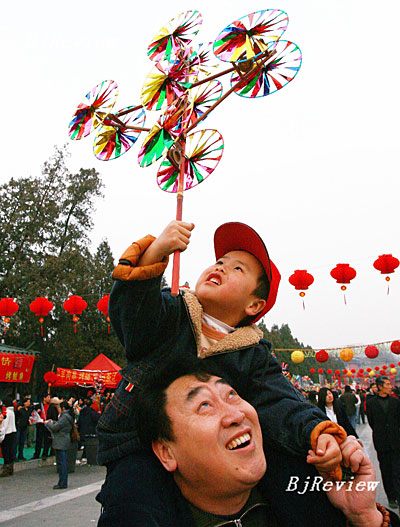| 
For the people of Beijing, no Spring Festival celebration would be complete without going to a temple fair. The outdoor events are a mixture of stage performances, tasty snacks and vendors selling toys in a festive and boisterous atmosphere.
The tradition of hosting temple fairs originated from religious activities at Buddhist and Taoist temples. In the first century, Buddhism started to spread to China from India while China's homegrown religion Taoism started to take shape. To expand their influence, the two religions competed to build temples and attract believers. When the two religions held services during festivals, believers volunteered to congregate in the temples, which became the earliest form of temple fairs. During the evolution of the temple fairs, the religious color gradually faded and entertainment became their prime purpose.
Of Beijing's many temple fairs, the best known are those at Changdian, Dongyue Temple, Baiyun Temple and the Temple of Earth. Changdian Temple Fair was originally held on open ground outside of Liulichang, now a pedestrian shopping street full of curio and antique shops. The fair, which occurs from the first to the 15th day of the first month on the lunar calendar, has everything one could expect of a temple fair. Besides window-shopping at bookstores, crafts shops and antiques shops, visits to famous homes, including that of the first generation of Peking Opera performers, also make a visit to the fair a unique experience.
Dongyue Temple, located on Shenlu Street or 1.5 miles east of Chaoyangmen subway station, is an imposing Taoist temple with a history of over 600 years. The temple worships the God of Mount Tai, who was believed to protect emperors, the God of Hell and the God of Marriage.
The Spring Festival of 2008 will witness the reopening of the west court of the temple after more than half a decade closed. People at the Dongyue Temple Fair will be the first batch of tourists to see the sculptures of the God of Marriage and of ancestors of different folk crafts.
The 19-day Baiyun Temple Fair near Xibianmen will be the longest temple fair in Beijing, where tourists can take part in religious rituals.
The temple fair in the Temple of Earth near Andingmen is known for the diversity of its opera performances, traditional crafts exhibitions, and vendors of numerous goods and snacks. The temple has been the altar for 15 Chinese emperors to worship the God of Earth for 381 years since the 16th century.
With the approach of the Beijing Olympic Games, almost all temple fairs will try to add some Olympic elements. The fair at the Temple of Earth this year has the theme of "an international and Olympic temple fair." The bustling marketplace during the weeklong Spring Festival holiday at Longtanhu Park has built facilities for visitors to join in sports activities of the 28 Olympic events, including shooting, sailing, boxing and rugby. Organizers of the Lotus Pool Temple Fair in Lianhuachi Park have designed a signature rally allowing people to guess the medal tallies of the Beijing Olympics. |